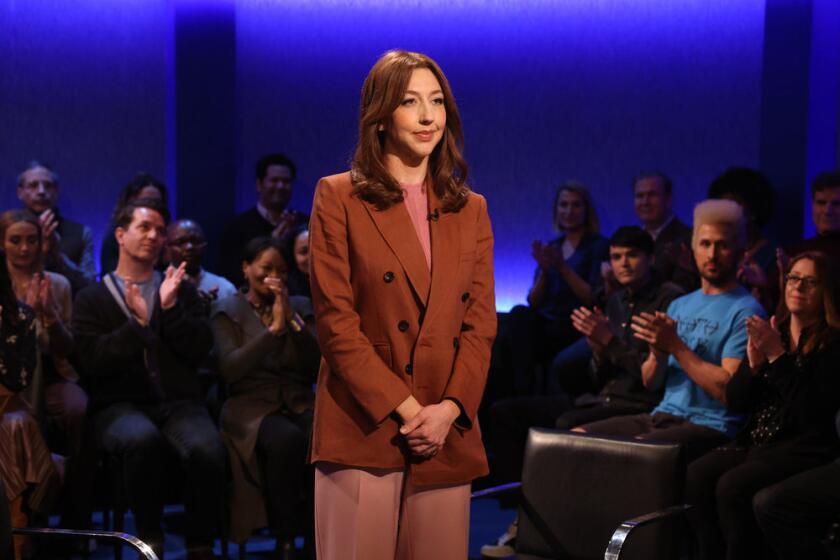Will stoop for scoop
IN real life, Courteney Cox, who plays the rapaciously ambitious editor of a tabloid magazine on the new FX series “Dirt,” has pretty much gotten used to the guys with cameras who lie in wait as she exercises on the streets near her home. But what creeps her out most about this weird price of fame is not being able to spend a carefree day at the beach with her little girl. (And don’t even ask about Coco’s paparazzi-studded 2nd birthday trip to Disneyland earlier this year.)
Likewise, Matthew Carnahan, the attractively disheveled creator and executive producer of “Dirt,” has also had his brushes with paparazzi. When Helen Hunt, the woman he jokingly called his “baby mama,” was pregnant with their toddler in 2004, photographers would leap out at her, brandishing their cameras like weapons, causing something to rise up in him that, uncontrolled, might have led to litigation.
Now, after creating “Dirt’s” protagonists -- the cold editor, the unhinged paparazzo -- Cox and Carnahan are finding that they feel ever so slightly sympathetic toward the intensely competitive tabloid editors and photographers whose job it is to make life hell for celebrities so that we may enjoy their fashions and foibles.
“The thing I understand more that has allowed me not to be a hard
It would seem that “Dirt” -- in a salacious and successor-to-”Nip/Tuck”-ish way -- is very much a show of this moment and, certainly, this place. As Carnahan has said, “We’re either at the pinnacle or the nadir of tabloid culture, so it’s a really good time to be doing this show.”
“Dirt” is an exploration of the weird symbiosis and Faustian trade-offs between parts of the star machinery -- the B-listers who sell out the A-listers in exchange for media consideration, the modestly paid network of valets, shopkeepers and workers at restaurants and clubs who keep the photo agencies tipped off about stars’ whereabouts, the stars’ dependence on being in the public eye.
There is probably no story line in this series so far-fetched that it hasn’t already happened in real life. Rick Fox plays a pro basketball player who is set up when Dirt hires a hooker to pose as a fan and get him into an outdoor hot tub for a sex romp. Click! (Remember Frank Gifford’s moment of shame in a New York hotel with a woman paid by a tabloid to entice him into a tryst? And not to put too fine a point on it, but even Fox has been there, done that. In 2004, tabs published shots of Fox, then married to Vanessa Williams, kissing a blond woman in a bar. His marriage to Williams crumbled later that year.)
Cox and her husband, David Arquette, both executive producers of “Dirt,” bring their experience to the table. For instance, Cox said she has a friend (not a “Friend” friend, she insisted) whose honeymoon was beset by a paparazzo who dug what was essentially a grave on the property to shoot the newlyweds in, yes, a hot tub. In exchange for not printing the shots, the magazine that had commissioned the photos (she wouldn’t say which) demanded that a favor be returned.
Fleshing out the unsavory protagonists -- particularly Cox’s editor, Lucy Spiller, and the photographer Don Konkey, played by Ian Hart -- was a challenge for Carnahan. When he first set out to create the photographer’s character, he said, both Cox and producer Thea Mann insisted that the shooter be “the lowest of the low.”
Carnahan could not write a character that he couldn’t love. And so, drawing on research he’d been doing for another project about mental illness, he invented a somewhat endearing character, a “functional schizophrenic” whose illness often puts him in the grip of hallucinations and paranoia. For viewers, this adds a surrealistic component to the show: Girls on Clairol boxes become a Greek chorus; raindrops spatter like blood.
Cox ended up recruiting some of the paparazzi who were bothering her and invited them to be interviewed about their work.
As for the editor, it’s not clear in the first several episodes what, exactly, will be lovable about Lucy Spiller, who is frigid in all the usual senses. She Tasers a lover after a one-night stand, casually engages in blackmail, fires subordinates for minor infractions and reads page proofs in bed while masturbating. Monica? Is that you? (“I am faking it, obviously,” Cox said, “but I remember sweating about that one.”)
In their research for the show, Carnahan and Cox met with several high-profile editors, including Janice Min of Us Weekly and Rebekah Wade of Rupert Murdoch’s Sun tabloid, which has the highest circulation of any English-language newspaper in the world.
“I was knocked out by how brilliant she was,” Carnahan said. “Smart, funny, engaging, mischievous, clever. Not morally corrupt. Morally complex.”
Cox spent time with Jane Pratt, the founding editor of Sassy and Jane magazines (and, incidentally, the short-lived Dirt, which was aimed at teenage boys), who is one of her closest friends.
The one major editor they don’t mention hovers over the show as a sort of ghostly inspiration.
Carnahan and Cox say they have never met her, but it’s hard to get away from the idea that Spiller is a fictional spawn of Bonnie Fuller, the calculating and driven magazine editor who has not just sated but helped create the appetite for empty-calorie celebrity coverage and who currently sits atop the heap at American Media, the conglomerate that owns Star and the National Enquirer. Her formula of sex, photos and grabby captions was developed during her meteoric rise, which has included stints at Marie Claire, Cosmopolitan, Glamour and US Weekly.
“I never met Bonnie Fuller,” Carnahan said. But, he added, “Her reputation looms large over this world. So I am sure there are pieces of Bonnie Fuller in there, and there is so much great apocrypha.”
Added Cox: “People will make assumptions, and it’s so not about her.”
But like Fuller, Spiller rationalizes that what she prints is defensible as the truth. “It’s not really her right to expose people’s truths, but in her mind it is,” Cox said of her character. “In her mind, she has a job to do.”
And the fruits of that job, as even the most put-upon celebrity will attest, are ravenously consumed by an insatiable public. Cox, whose 2 1/2 -year-old daughter knows the word “paparazzi,” loathes unflattering photos of herself but is tickled by flattering ones. “It’s a human impulse,” Cox said. “I like to look at the pictures.”
Carnahan said there is not a moment in the writers’ room when one of them is not lost, utterly lost, in the pages of a glossy weekly or one of the tabs. “I started reading the tabs for research,” Carnahan said, “but I’m like the actor who decided to try heroin because I was playing a junkie.”
Nearly 10 years ago, after Princess Diana was killed in an alcohol- and paparazzi-fueled car chase in Paris, Carnahan remembers thinking that some sort of cultural apocalypse had taken place, that the celebrity obsession that so clearly contributed to her death would change. “I thought, now we are going to shift into something more elegant, more distanced, more objective, more human,” he said.
“Boy, was I wrong.”
*
The complete guide to home viewing
Get Screen Gab for everything about the TV shows and streaming movies everyone’s talking about.
You may occasionally receive promotional content from the Los Angeles Times.




